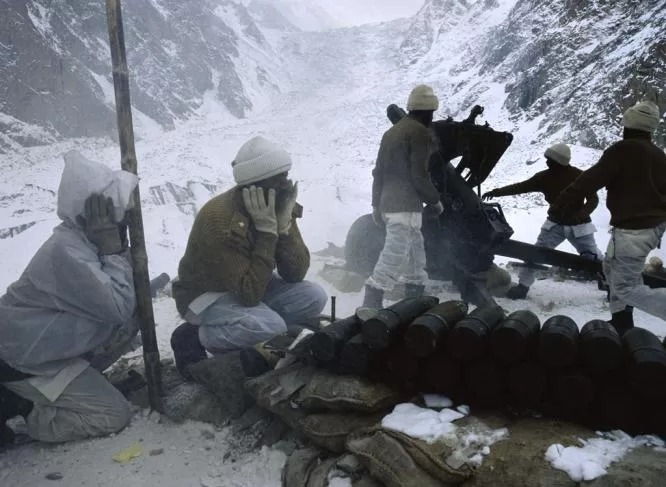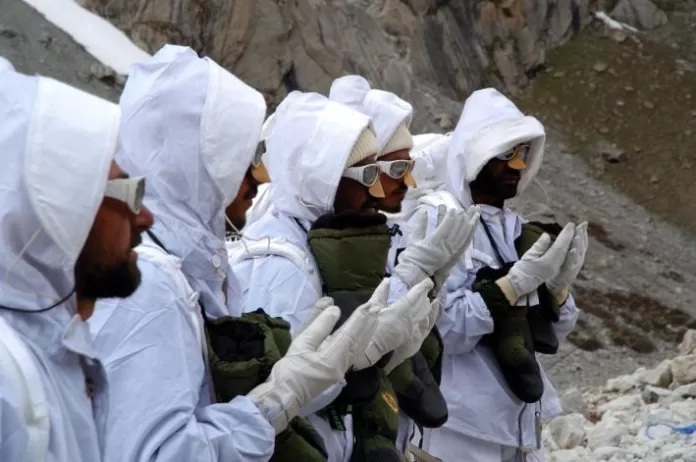A visit to Siachen 12 years after it became the highest and coldest battleground in the world evoked “WITHERING HEIGHTS” (Sep 19, 1996), “The watershed for the Indus and Tarim River Basins, the sparsely populated Karakoram Ranges has four peaks exceeding 26000 ft, K-2 being the world’s second highest mountain after Everest. The Karakorams are basically a group of parallel ranges with several spurs, characterised by craggy peaks and steep slopes. The southern slope is generally long and very steep in contrast to the northern slope which is steep and short, this has allowed Pakistan to bring roads and tracks right upto most of the posts while the Indians on the northern (and reverse) side are supplied mostly by choppers, entailing expenditure five to six times that of ours. Cliffs and great accumulations of large, fallen rocks (taluses) occupy a vast area with traverse valleys looking like narrow, deep, steep ravines, “unquote.
One of the world’s longest mountain glaciers, the 3 kms wide Siachen extends 70 kms from north-northwest to south-southeast, with a number of fast flowing streams. For the most part the climate semi-arid and sharply continental, the southern slopes are exposed to the humidifying influence of the monsoons coming in from the Indian Ocean while the northern slopes are extremely dry at altitudes of more than 16000 feet. The average temperature above altitudes of 18700 feet during the warmest month is below zero, between 12800 and 18700 feet it remains around 10˚ C. The wind chill factor takes the temperature 50˚ C below zero 9 months of the year.
In August 1970 Col (later Maj Gen) NK Babar led a familiarisation flight for pilots of 4 Army Aviation Squadron, including Karakoram Highway (KKH), Flight first to Siachen beyond Skardu. Maj (later Maj Gen) HUK Niazi) flew an Alouette-3 with me to this desolate but beautiful place. The first impression one got of the craggy, snow-lined mountains in the proximity of the Siachen Glacier, could any place on Earth, however bleak, where there is both life and death, be without God? Only a short distance beyond village Demsome (than several huts only), the shortage of oxygen at that height gave us the first sign of breathlessness. My next visit was 26 years later to the Siachen Brigade, landing at Goma and Gayari before getting a distant aerial view of Bilafond La. Soldiers lived in synthetic-igloo lonely eyries atop nameless mountain peaks, in cold isolation for weeks at a stretch, survival against the vagaries, the extremes of nature and the environment was all what those who had to endure this asked for, man-made modes of death and destruction were a secondary consideration. The sheer magnificence and enormity of the tremendous landscape put one in a state of trance, in awe of the stupendous beauty, in awe of incessant danger, in awe of a seemingly impossible undertaking and above all, in absolute awe of the men who chose to live, and maybe, die there.
The 1996 article had noted, “Rarefied air, intensive solar radiation and great ranges of temperature, add to the vicissitudes of life. Mountain passes are situated at altitudes of 16000 feet, open only five/six months of the year. Daunting physical environment and extreme weather conditions notwithstanding, man is subject to the 3P’s, Pathological, Physiological and Psychological. Pathological effects include accumulation of water in the lung or in the brain, pulmonary and cerebral odema respectively, requiring the affected person to be brought down to lower heights immediately. In severe weather or fluid battle conditions, this becomes a difficult logistics operation. Snow blindness, frostbite and mountain sickness are also very common, debilitating ailments. On the physiological side, with temperatures even during summers 30-40 degrees below freezing and wind velocity reaching 70 kms per hour increasing multifold the wind-chill factor makes loss of sleep and loss of appetite common. Lack of oxygen at such high altitude reduces the work capacity of even trained and acclimatized men to 65%. The pathological and physiological pressures lead to psychological effects, with intolerance in the forefront, by-products are intimidation and rashness. The normal camaraderie between individuals is broken, with loss of respect only a snap away from indiscipline.” An incident in Siachen involving deaths of two Indian officers in a fire in a fiberglass hut in 2011 led “The Times of India” to note, “soldiers constantly battle high-altitude pulmonary odema, cerebral odema, hypothermia and frostbite in the extremely tough terrain, where avalanches, blizzards and white-outs are the norm”.

“What manner of men are these who have chosen to serve in such a desolate and dangerous mission? Coming from the finest that this country has given birth to, this is the flower of the Pakistani youth in full bloom, no grim faces here, only infectious smiles as well as a willingness and ready enthusiasm that is inspiring to those who are privileged to witness it. The maturity among the youthful faces is at once captivating as well as devastating. Why have all our flowers gone to mountain peaks everyone? To remain face to face with death so early in life for so extended a time on a daily basis is not what one would wish for anyone. As guardians of this country’s ideological and geographical frontiers, a more hostile environment for initiation from youth to manhood does not exist in this world. It is a sheer privilege to know such men, in the beauty and desolation of Siachen they are ever ready to go to war to keep the peace for their countrymen. You stand humbled in the vicinity of such an environment and in the presence of such men”, unquote. Can words do justice to such courage and endurance in this environment? Can words capture the pride in my unit 4 Sindh suffering casualties facing the brunt of transgressions natural and man-made (including the attack on Chulung La) during the early days 1986-1987 without proper equipment or logistics back-up?
The words penned by Vice Principal Hasan Abdal Cadet College, Abdul Qadir Saggu, for his beloved son Maj Zaka, buried at Gayari alongwith his fellow soldiers of the Northern Light Infantry (NLI) under an enormous landslide of tons of ice and rock, are specially poignant, “from the swirling turbulence of hope and despair, I can only bubble out these few words for my Zaka, farewell my son”, unquote. What chance do our soldiers have in such awful circumstances in the icy, wind-swept desolation of Siachen, and to what purpose?
The charge of the English horse cavalry against German Armour in World War I (fictionalized in a dramatic scene in the movie “War Horse”) evoked the comment, “C’est Magnifique, C’est pas la guerre”, it is magnificent but it is not war. Reality overwhelms hyperbole in Siachen, it is not magnificent but unfortunately it is war. Facing the ultimate test of human and logistics endurance for nearly three decades, Pakistan should unilaterally walk away from Siachen even if India chooses to keep on subjecting its soldiers to that freezing hell. Better still, both India and Pakistan should “declare victory” and bring our boys home from the cold, most wars are insane but what are we fighting for here?
Siachen is hallowed ground!
Courtesy: The News




